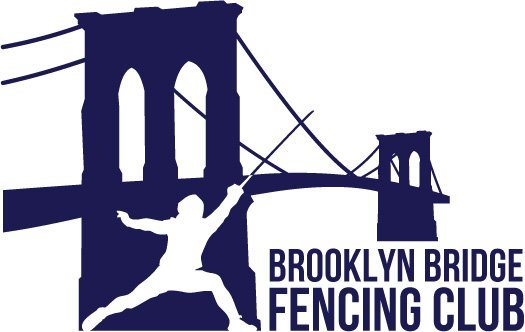We get a lot of questions about the equipment in fencing, usually about what’s needed for our classes. To start, Brooklyn Bridge Fencing Club provides all of the fencing equipment that you’ll need for introductory lessons or our recreational classes. You just have to wear athletic shoes and long pants and you’re ready to go!
Here, we’ll go over the equipment you’ll see around the club in practice, as well as what’s required for competitions.
All of the equipment icons were provided by www.clubweapon.com with their permission.
Fencing Jackets
Fencing jackets offer some padding, but primarily function as safety equipment to prevent injury.
When you purchase your own jacket, we can’t recommend getting a front-zip jacket enough. It will definitely improve your fencing life. Any standard jacket is legal for competition in the US. For international competition, the FIE (the international governing body of fencing) requires FIE-certified jackets.
Fencing Pants
In practice, BBFC requires long pants or fencing pants. Competition requires pants specifically for fencing. These pants will fasten just below the knee, so you’ll also need to wear long socks that cover the knees. Some vendors sell fencing-specific socks, but any soccer socks will do. International competition requires FIE pants as well.
Fencing Gloves
In fencing, you only need one glove on your weapon-hand. We sometimes see beginners stuff the cuff of the glove into the sleeve of the jacket, but the cuff needs to be on the outside to protect you from a point slipping up the sleeve. In class, we use standard fencing gloves that range from XS - XL. Higher quality gloves will usually have more specific sizes.
Foil does not require an FIE-certified glove, but competitions do typically inspect your glove for any holes or significant tears. Your glove will need to be in good shape to be approved for competition.
Fencing Masks
In fencing, each weapon has its own specific mask for competition. Foil masks have lamé material on the bib of the mask for use with the electric scoring system. For our beginner classes, we provide standard epee masks that have all the same safety features as the foil mask, just without the scoring part necessary for competitions. If you buy your own, you’ll want to get a standard foil mask along with the cords to attach to the rest of the scoring equipment.
In foil competition, you’ll need a mask with lame material on the bib as this is part of the target area. In the us, a standard foil mask is legal, but international competition requires and FIE-certified mask.
Chest Protectors & Underarm Protectors
Underneath the jacket, you’ll wear an additional layer of protection. The hard plastic chest protectors help with the impact of being hit while the soft underarm protector (also called a plastron) serves as a redundant safety layer on the weapon-arm side where you’ll receive the most hits. Competitions require a layer of approved foam over the hard plastic to reduce any ‘skipping’ of the opponent’s point on the hard surface. The hard plastic chest protector is optional for men, but mandatory for women. Underarm protectors are mandatory for everyone. At BBFC, we require boys under 10 to wear chest protectors as well.
Fencing Foils
In class, we use standard practice foils with French grips. These are inexpensive and can be a good starter weapon for your own, but we usually recommend that if you’re going to buy a weapon you go ahead and get a competition-ready foil. They’re a little more expensive, but overall more cost-efficient if you’ll end up competing later since the competition foil can still be used in practice.
To compete, you’ll need to bring at least two competition-ready foils with you. We recommend that you bring three. These electric foils have a plug so that they can be connected to the electrical scoring equipment. US competitions don’t require FIE certified foils like international competitions do, but this is one place where we do recommend making the upgrade anyways. An FIE foil can be twice as expensive as a non-FIE blade, but it can easily last more than twice the lifespan before breaking.
Fencers 10 and under are required to use Size 2 blades. Everyone else should get size 5 blades.
Our club recommends 2-pin plugs for the socket type, and x-small or small visconti grips for children.
Foil Lame
For electric fencing, you’ll need to wear a special vest that designates the target area in foil fencing (the torso). You only need one foil lame to compete. The inexpensive lames are typically lined with copper which can oxidize and turn green over time. The more expensive lames typically use nickel and other tarnish-resistant materials. Be sure to get a front-zip lame!
Body cords & Mask cords
Electric fencing will require a body cord that runs from the weapon, up the sleeve of the fencing jacket, and hooks into the electric scoring system. You’ll also need a cord that connects your foil lame to the bib of your foil fencing mask. Competition requires twosbody cords and two mask cords, but just like with the foils we recommend that you bring three of each.
Our club recommends 2-pin style body cords to go along with the 2-pin sockets recommend on the weapon.

















